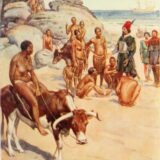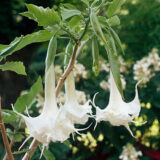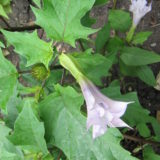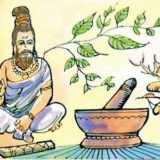Table of Contents
What Herbal Teas Have Ceremonial Uses?

Herbal Teas With Religious Significance
The many ancient and long standing religions of Earth have revealed a number of hallucinogens and psychoactive compounds which have been used in religious ceremonies. Many times these substances are taken in a beverage, tea-like form, probably because it is easiest to prepare and consume quickly. In some religions and ceremonies, only a priest, shaman or religious figure partakes in the herbal tea. Other beliefs and/or conjugations may dictate everyone, or a select group of individuals, partake in consuming herbal tea. In some cultures, a bride and groom and their “priest,” take a substance together, other times it is just the bride and groom. Sometimes, psychoactive herbal teas are available for entire attendees of an event.
The religious significance of these plants can be restricted in certain religions to shaman only, who use the herbal teas to communicate with the Gods, a particular God or the dead. There are also shamanic rituals which involve consuming these plants to diagnose or otherwise investigate an illness or disease. They are sometimes used for prophecy, to see into the future or the past. While these herbal teas may have many uses for many different religions, all of the plants on this list have had some sort of religious significance at one point in time or another. Some are still significant in some religions to this very day!
List of Herbal Teas With Religious Use
This is a comprehensive list of herbal teas used in a ceremonial or religious way, in their respective geographical region. This list is in alphabetical order.
Ayahuasca
Ayahuasca is an Amazonian drink made typically from a number of ingredients. Although the primary hallucinogenic ingredient can sometimes change from culture to culture, it is most commonly found to be Banisteriopsis caapi. This vine is very special for its high DMT content, which is the hallucinogenic tryptamine derivative responsible for making the drink so popular in religion. It is a powerful spiritual and psychological tool and can be used to “cleanse the soul” in a special religious-spiritual retreat. It is also used by shaman and medicine men to diagnose in their respective cultures. Ayahuasca is most popular for its ability to induce self-soul searching.
Cannabis
Cannabis has been most popularly smoked, however, many religions around the world have long prepared a powerful cannabis tea for their rituals. There are many religious ceremonies which brew a marijuana tea for the entire conjugation, but also some which consider it a more “personal” and “enlightening” journey; And much like Ayahuasca, those religions hold a much higher regard for preparation of the journey and analyzing its meaning. Marijuana has been spiritually significant to many cultures, but is most notably brewed as a tea in India.
Fly Agaric Mushroom Tea
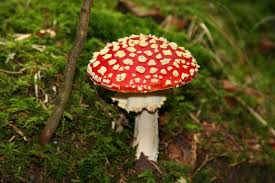
Fly Agaric has been used for more than ten thousand years. Many cultures throughout that time have found these mushrooms religiously significant. They have had a lot of shamanic purposes due to their inebriating effects. Fly Agaric mushrooms can be brewed into a strong, psychoactive tea. Shaman use this tea to enter states of trance and for prophecy. Some Native American rituals have made use of the Fly Agaric herbal tea. Some Indian religious rituals have made use of an herbal tea from these mushrooms as well. The Indians specifically used it to contact their Gods. Celtic druids are also famous for using it in meditation and a variety of ceremonies.
There is one distinct ritual in the Siberian region of the world by the Koryak people, whom select a shaman to consume large quantities of the mushroom all at once…to serve the masses. The shaman must fast for a long time before the ritual, to ensure there is nothing else in the digestive tract. As the mushrooms work through a well-fasted stomach, the toxins are stored in the stomach to exit via feces later on…while the water and hallucinogenic compounds from the mushrooms are worked through the shaman’s system and passed through the urine in a concentrated, stronger form. Extra ingredients are sometimes added to make an herbal urinal tea, which is consumed by everyone else partaking in the ceremony.
Heavenly Blue Morning Glory
The Morning Glory seeds contain LSA (Lysergic Acid Amide), which is a natural-form of LSD. These seeds have had a lot of shamanic and religious significance throughout Mexican and Central American tribes for centuries. Some Native Americans have also been known to make use of Morning Glory Tea. Typically Morning Glory Herbal Tea is used to create trances and visions. It can be used for prophecy or for self-enlightenment. It has especially been significant within the many religious cultures of Oaxaca, Mexico. This is a highly hallucinogenic plant. As an herbal tea, the hallucinations are typically audible to begin with, and in higher doses, visual and dream-like. LSA does have a significant impact on dreaming and has been used by shaman to induce prophetic dreams.
Henbane
Henbane, or Hyoscyamus niger can be a beautiful plant…and also a deadly-looking one. It is very commonly known to be associated with witchcraft and the occult. Most cultures steer clear of it, thinking it purely poisonous. This is probably because it actually is dangerous in large enough quantities, and before that, it is strongly hallucinogenic. The hallucinations can become delirious under the wrong conditions or with too high of a dose. They are often described as soaring, levitating and dissociative feelings. Many of the “more modern” Henbane herbal tea trips for religion are closely tied to the Pagan religion and prophecy. Some of the older religious uses include a number of cultures throughout the middle ages, and even as far back as the ancient Greeks. Sometimes it is combined with other ingredients to form a more powerful or more sedating hallucinogenic tea. There are some religious ceremonies which use Henbane concoctions of smaller psychoactive contents, yielding a more stimulating effect.
Jurema
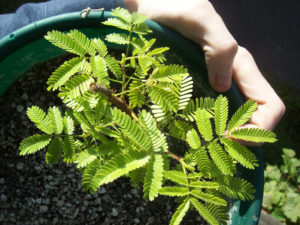
Jurema is also known as Mimosa hostilis and has significant religious and spiritual significance all throughout Oaxaca and the Mexico region of the world. It is also popularly used throughout Amazonian and South American religious tribes. Traditionally it would be combined with other plants to produce strong, hallucinogenic or otherwise psychoactive effects. It is considered sacred by many shaman who use it for the visions it can induce. Still to this day, it is used by shaman in some Mexican, Central and South American cultures. Herbal tea prepared from Jurema has also been used to treat pain and even tooth ache.
Kava Tea
Kava Kava is often found in social pubs in the tropical regions of the world…and is a well-known intoxicant. However, Kava tea has been brewed for religious purposes in some cultures as well. Typically Kava is prepared in a rather unhygienic fashion, involving the pre-chewing and foot-stomping of the roots before it is then brewed into a really nasty looking herbal beverage. This brew is still consumed and provides some pretty potent shamanic effects. Modern preparations are a little more hygienic and socially acceptable to Western culture, but there are still many tribes around the world that partake in the old fashioned, traditional preparation methods.
Kratom Tea
Kratom is a really powerful inebriant and intoxicant when consumed in large quantities. It can be stimulating, encouraging conversation and even euphoric. It is a favorable mood enhancer and can promote the feeling of closeness to others. It is sometimes described as a Percocet, which does make sense being the active constituent alkaloids dock with the opioid receptors. Kratom has a long history of being religiously significant. Kratom tea has been brewed for religious gatherings and religious-social events. Kratom tea has also been used by Buddhist monks for enhancing meditation. It is a powerful psychoactive substance that can alter the mind and mood simultaneously and a number of tribes in Asia have found spiritual purposes for the Kratom ceremonial tea.
Manaka Root
Also known as Brunfelsia chiricaspi, Manaka tea is often served at religious and important spiritaul functions throughout several tribes of the Amazon. They also play a part in many Ayahuasca preparations, and thus, can be considered part of hallucinogenic concoctions. By itself, it is also commonly employed as a healing tea.
Peyote Cactus
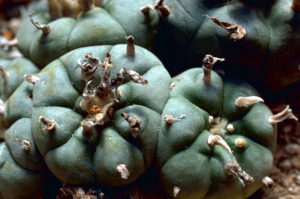
Peyote has a lot of religious significance across the the Native American and tribes of Mexico and Central America. Mescaline is a powerful hallucinogen, and it is the primary constituent responsible for Peyote receiving such extreme religious significance. There is even a religion known as “Peyotism,” mostly a sect of the Native American Church (NAC). The Native American Church and its Canadian counterpart, are the only two entities which have been granted the legal right to cultivated, harvest, manufacture or otherwise use Peyote in a non-decorative or ornamental fashion. Peyote tea is extremely psychedelic, but holds powerful “spirit journey” significance in many tribal cultures, as well as within the NAC.
The Native American Church is an interesting combination of Christianity with Native American tradition…and a special psychedelic sacrament. That special psychedelic sacrament, obviously being Peyote. The religion may have started out small, but today the NAC boasts more than a quarter million followers. Many of their Peyote ceremonies are musical and vibrant. They are sometimes very social and often considered fun to attend and experience. The NAC believes in one ultimate God, known as the “Great Spirit” and some believe Peyote allows them to receive messages from this God, and experience moments of lucidity, transcendence, spiritual growth/exploration, and singularity with the Universe.
Salvia
Salvia divinorum, also known by many other names including Sage of the Diviners and the Seer’s Sage, is a powerful psychoactive drug. The hallucinogenic compound Salvinorin A is known to send people into crazy delirious trances that can be used for prophecy or self-exploration. Salvia is a very common drug found among shaman and medicine men of many cultures. It is very commonly used by Shaman for communicating with the dead, Gods and to diagnose illness. A ceremonial Salvia tea is one of the most powerful hallucinogenic teas known to man. In fact, Salvia has (on many occasions) been hailed the strongest hallucinogenic substance on Earth. The trances are short lived, usually only lasting a period of 3-20 minutes (depending upon preparation and dosage [aka how much tea is consumed]), making it optimum for many religious purposes.
Teonanacatl
Magic mushroom tea is very popular in many religious sects around the world. It is very commonly found among shaman and within a variety of religious and ceremonial rituals within Oaxaca religions. There are many Mexican tribes, in fact, which have used Teonanacatl tea for spiritual exploration, healing and prophecy. Central and South American cultures alike have found strong spiritual and divine significance in mushroom tea of the psilocybin variety. Many religious leaders use magic mushroom tea before ceremonies. Magic mushroom tea is also used in many social gatherings within a number of religions.
Wormwood
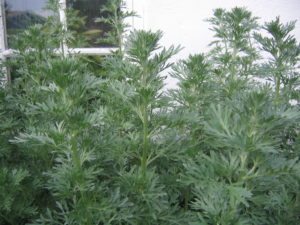
Also known as Artemisia absinthium, Wormwood is probably most famous for being combined with alcoholic concoctions (hence the popular Absinthe). Wormwood has found religious significance in many cultures including the Aztecs, Neo-pagans, and even Native Americans. The Aztecs believed Wormwood tea was a religious remedy for spiritual and ailments of a divine origin (such as curses or God-induced punishment). Because it frequently grows in cemeteries, it is often considered a superstitious plant. Thujone is the active constituent of Wormwood which is thought to be responsible for the psychoactive effects which was experienced by the pre-banned, original Absinthe beverage formula. It is a dangerous substance, admittedly, as a dose can be barely effective for one person, while nearly deadly for another. Even though it can be deadly rather easily, it is still closely related to THC (which is regarded as relatively safe). Wormwood is mentioned in the Bible, and is sometimes used to brew a tea which isn’t even consumed by humans, but instead used to water plants.
Herbal Teas and Religious Purposes
Herbal teas and beverages have always been a big part of some of the oldest religions known to man. Many of these concoctions are either inebriating or hallucinogenic. All of them are psychoactive. Traditional recipes may vary from culture to culture and religion to religion, but it is certain there are many effective preparations for each plant. Some of them are combined with other ingredients to strengthen or otherwise enhance their effects, while others are used solely by themselves. Admittedly though, in modern time, most of these plants have been used more for recreational purposes than religious purposes.
